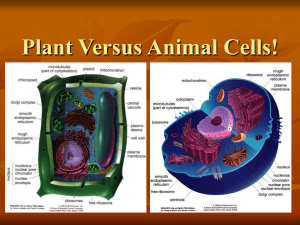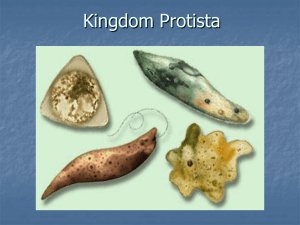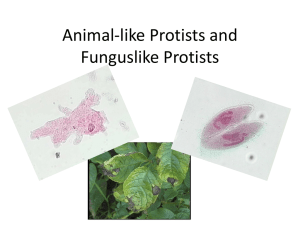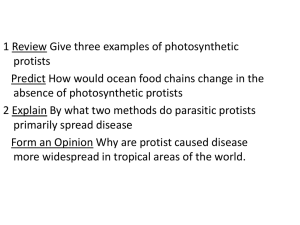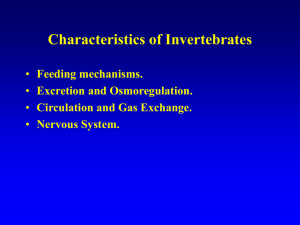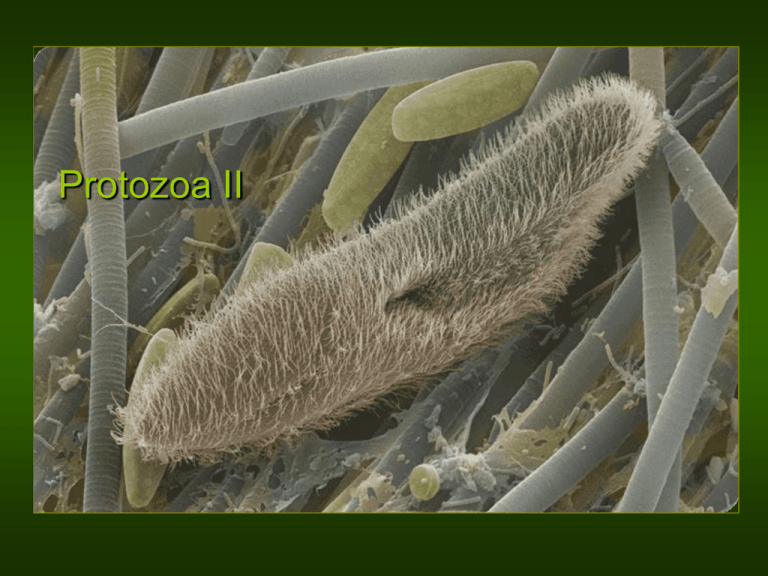
Protozoa II
Support and Locomotion
Locomotion depends on interactions between cell
surface & surrounding medium
Protozoa were originally classified according to
how they move.
Locomotion
Flagella
Cilia
Pseudopods
Some are non-motile
How Do Protists
Move?
• Pseudopods
• Flagella – long, whip-like “hairs”
• Cilia – short, fine “hairs”
• Some are non-motile
Pseudopodia
Lobopodia
Chaos,
Arcella
Filopodia
Difflugia
Reticulopodia
Foraminiferans
Axopodia or Actinopodia
Actinosphaerium,
Radiolarians
Hyaline cap
Chaos
Arcella
Lobopoda
Lobopodia
Difflugia
Foraminiferans
Reticulopodia: Bidirectional
cytoplasmic streaming
Actinosphaerium
Radiolarians
Actinosphaerium
Axopodia: Bidirectional cytoplasmic
streaming
Climacostomum
Rows of
kinetosomes
(basal bodies)
Dynine arms have ATPase activity
When dynine arms use ATP, microtubule
doublets slide past each other
When microtubules slide past each other the
flagella changes shape
Cilia Movement
Power Stroke
Recovery Stroke
Tetrahymena pyriformis
Conchothirus
membranelle
Cilia in adjacent rows
lean towards each
other
Basal body
cirrus
Stylonychia
membranelles
Undulating membrane
Flattened sheet of cilia
Stylonychia
Ciliate Pellicle with Alveoli
Ca ++ storage
Defense
Flagellar
Movement
metaboly
Metaboly
Astasia
Euglenophyte Swimming
Swim by one or two flagella; only the tip of flagellum is
moving, propelling the cell forward
Light sensing system: 2 major parts,
paraflagellar rod at the base of at least the emergant
flagellum; contains light-sensitive flavins
Eye-spot (stigma): in the cytoplasm adjacent to the
ampulla; bright orange by carotenoids
Light direction: the eye-spot shades the paraflagellar
body while cell is swimming in rotating movements
along its axis
Positive phototaxis: most phototrophic euglenophytes
swim towards the light source
Chlamydomonas reinhardtii.
Eyespot/cv/chloroplast
Tinsel Flagella
(Flimmergeisel)
Myonemes – “muscle-like”
Myonemes – “muscle-like”
Myonemes – “muscle-like”
myonemes
(protein that plays a major role in
the formation of coated vesicles)
Lysosome
Nutrition
Some are autotrophs
Photosynthetic
Chloroplasts
Endosymbiotic algae
Most are heterotrophs
Saprobes
(Saprozoic) - feed on dissolved
organic molecules
Decomposers
Parasites of animals
Holozoic
- feed on particles
Nutrition - Autotrophs
Photosynthesis
Photosynthetic
protists & bacteria - dominant carbon
producers in oceans and lakes.
Nutrition - Autotrophs
3 key themes of the evolution of
photosynthesis in protists:
Different
groups of algae can be distinguished by the
photosynthetic pigments they contain.
Different pigments absorb different wavelengths of
light.
Diversity in pigments lets different types of algae
inhabiting the same area to absorb different
components of available light.
So different types of algae live at different
depths.
Absorptive Feeding
Physarum sp.
Entamoeba histolytica –
traveler’s diarrhea
Nutrition
Absorptive feeding
Some
protists are decomposers and feed on
detritus (dead organic matter).
Secrete enzymes to breakdown organic molecules
Absorb these smaller molecules through cell
membrane
Parasitic
protists absorb their food inside a
living host, and may damage the host.
Nutrition
Holozic or Ingestive feeding
May
ingest particulate detritus
Many protists are large enough to engulf bacteria
& other protists, by phagocytosis. These
predators are referred to as raptorial.
Phagocytotic protists lack cell walls and have
flexible membranes and cytoskeletons that they
can use to surround potential food sources.
These innovations allow them to eat other cells
instead of competing with them for food or
sunlight.
Feeding & Excretion
Phagocytosis
Feeding & Excretion
Phagocytosis
Feeding & Excretion
Phagocytosis
Feeding & Excretion
Exocytosis
Feeding & Excretion
Exocytosis
Feeding & Excretion
Exocytosis
Feeding & Excretion
Exocytosis
Feeding & Excretion
Exocytosis
Holozoic protists obtain food
in a variety of ways:
Active
predators hunt down
their food by moving through
their habitat and engulfing their
prey.
Ambush
predators sit and
wait for prey to come by, or
have cilia that move the
environment past them.
Filter
feeders collect food by
sweeping water into their
mouth usually using cilia.
Food Vacuoles/
Phagosomes
Paramecium
food vac
cytoproct
Reproduction
Highly variable
Often very complex
Asexual
binary fission produces 2 equal daughter cells
budding produces unequal daughter cells
schizogony produces multiple equal daughter
cells
Reproduction
Binary fission (mitosis)
asexual reproduction- the
cell divides into two
Genetic recombination
Conjugation (ciliate sex)
see Brusca p. 143
Two cells exchange copies of
their micronuclei, leading to
genetic recombination
Binary Fission
Mother cell
Daughter cells
Sexual Reproduction
Involves meiosis
Production
of gametes
Isogametes - same size gametes
Anisogametes - gametes different size, appearance
Fertilization
Syngamy
= fusion of gametes
Union of haploid gametes to produce diploid
zygote
Source of genetic variation
Sexual Reproduction
Conjugation is sexual reproduction
without gametes
Conjugating
micronuclei
cells exchange haploid
Autogamy
Necessary
for long-term survival of ciliates
Reorganization of genes in macronucleus
Similar to preliminary steps for conjugation
New Genotypes may be formed so this is a source
of genetic variation w/o sexual reproduction
Ciliophora
Dimorphic nuclei
Heterokaryotic
• Macronucleus =
multiple dispersed
copies of genomeused for transcription.
• Micronuclei (one or
more) = condensed*
copies of genomeused for replication
and conjugation.
*what does this mean?
Conjugation
Figure 03_18
Binary fission in Stentor coeruleus
Autogamy– nuclear reorganization
Necessary for long-term survival of ciliates
Reorganization of genes in macronucleus
7 nuclei disintegrate, get one remaining haploid
micronucleus that undergoes mitosis to give 2
micronuclei which then fuse
m
M
M
M
Animals
Many Algae
Plants
Alternation of Generations
Unnumbered table 03_01
Go over Research Focus Box 3.1;
explain experiments.
What is phenotypic plasticity?
Protozoan Diversity
Go to “Protozoa” in Lab Stuff


